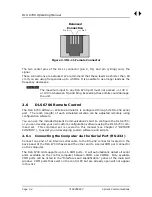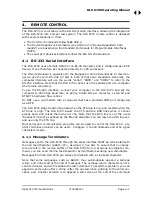
Chapter 4: REMOTE CONTROL
Spirent Communications
7104000557
Page 4-3
4.3 Command Syntax
The DLS 6700 adheres to the IEEE 488.2 format for command syntax. As with the
Data Format, the principle is Forgiving Listening and Precise Talking.
Commands may take one of two forms: either a Device Dependent Command starting
with a colon (Section Section 4.3 "Command Syntax") or a Common Command start-
ing with a star (Section Section 4.5 "Common Command Set"). Each type may be pre-
ceded by one or more spaces, and each must have one or more spaces between its
mnemonic and the data associated with it.
Common commands are preceded by the character “*”. Device Dependent commands
are preceded by a colon, with a colon separating each level of the command. Com-
mands may be either in upper or lower case. Multiple commands may be concate-
nated by separating each command by semi-colons.
The following are some examples:
*RST
*RST;*WAI;:SET:CHANNEL:LINE 1, 4000 ft
*ESE 45; *SRE 16
Messages to the DLS 6700 must be terminated with a Line Feed character (ASCII
<LF>, decimal 10, hex 0A). Messages from the 6700 are always terminated with a
Line Feed character.
As defined in the SCPI specifications, a Device Dependent Command may be sent in
its short form or long form, in upper or lower case. The following commands are
therefore identical in operation:
:SET:CHANNEL:LINE 1, 4000 ft
:SET:CHAN:LINE 1, 4000 ft
Queries of the system follow the same format as the commands, except that the data
normally associated with a command is replaced by a question mark “?”. Following
receipt of such a command, the DLS 6700 will place the appropriate response in the
output queue, where the controller can read it. Examples are:
*IDN?
*ESE?;*SRE?
:SET:CHAN:LINE?
When a command does not begin with a colon, the DLS 6700 assumes that the com-
mand is at the same level as the previous command. For example, to set a line one
does NOT need to specify “:SYS:CAL” each time, as in:
:SYS:CAL:Date Dec 2001;Expiry Dec 2002
This shorter form is valid because both LINEs are at the same level.
4.4 Device Dependent Commands
As recommended by the SCPI consortium and to simplify programming of the various
Access Emulation Division simulators, the DLS 6700 uses the following tree structure:
:SETting
:CHANnel
Summary of Contents for DLS 6700
Page 1: ...P N 7104000557 User Guide DLS 6700 Operating Manual Version 1 02 Nov 2004...
Page 26: ...DLS 6700 Operating Manual Page 4 12 7104000557 Spirent Communications...
Page 28: ...DLS 6700 Operating Manual Page 5 2 7104000557 Spirent Communications...
Page 30: ...DLS 6700 Operating Manual Page 6 2 7104000557 Spirent Communications...
Page 34: ...DLS 6700 Operating Manual Page 8 2 7104000557 Spirent Communications...
Page 36: ...DLS 6700 Operating Manual Page 9 2 7104000557 Spirent Communications...
Page 42: ...DLS 6700 Operating Manual Page 11 4 7104000557 Spirent Communications...
Page 46: ...DLS 6700 Operating Manual Page A 4 7104000557 Spirent Communications...
Page 48: ...DLS 6700 Operating Manual Page B 2 7104000557 Spirent Communications...















































